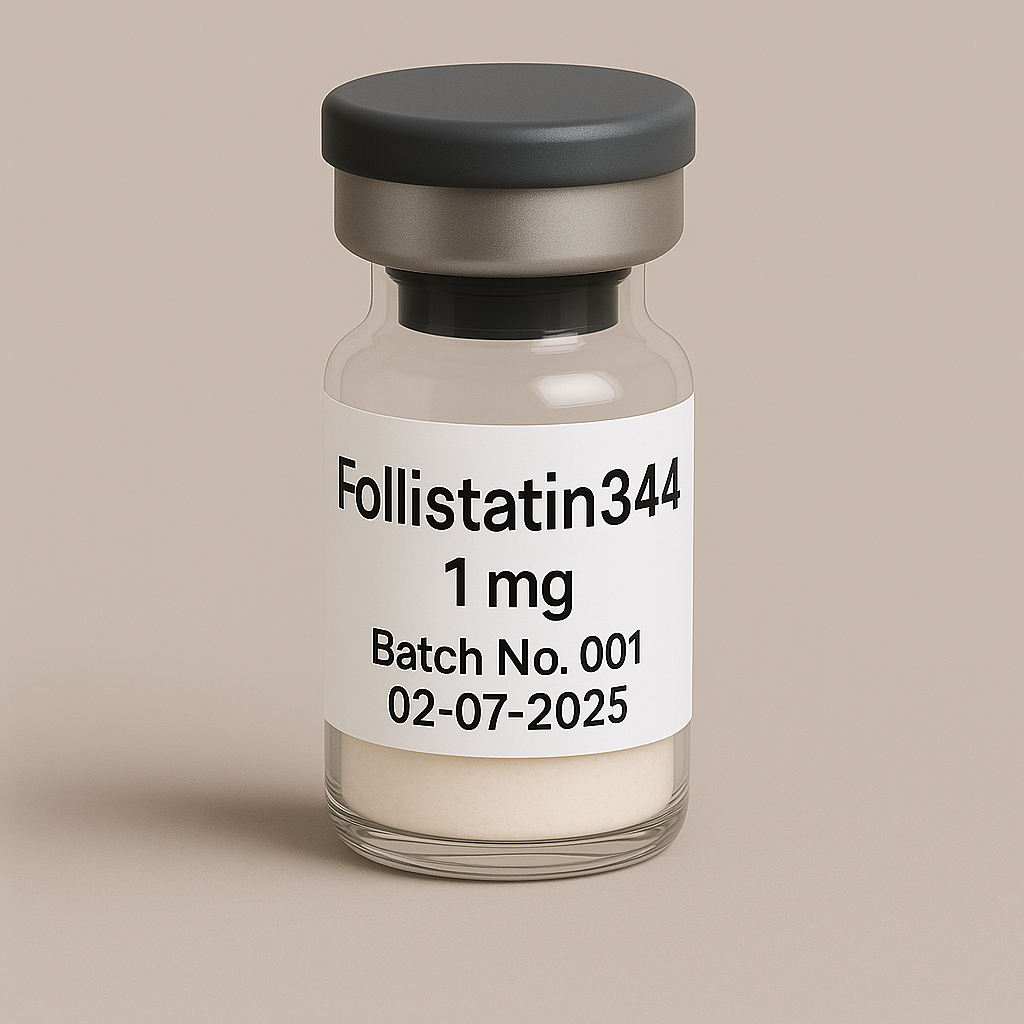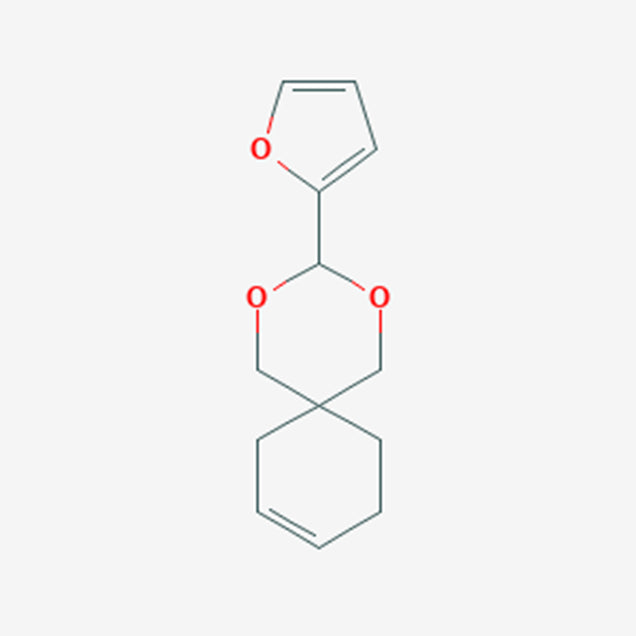
Follistatin344 1mg vial
Pickup currently not available
NOT FOR HUMAN CONSUMPTIO
Follistatin-344 is the 344–amino-acid pre-pro–follistatin isoform encoded by the human FST gene. After secretion-signal removal and proteolytic processing, FS-344 yields the circulating follistatin-315 (FS-315) glycoprotein; an alternative splice variant, FS-288, is more heparan-sulfate–bound and tissue-retained. Follistatin is a ligand trap for activins (A/B), myostatin/GDF-8, GDF-11 and some BMPs, preventing their engagement of ActRIIA/B–ALK4/5receptors and downstream SMAD2/3 signalling. Functionally, this de-represses myogenesis, reduces catabolic signalling, and can remodel fibrosis and inflammation. In translational work, “AAV1-FS344” denotes a gene-therapy cassette that drives FS-315 expression after in-vivo processing. Not FDA/EMA-approved.
Additional Benefits of Follistatin-344 Now Under Investigation
| Benefit | Key take-aways |
|---|---|
| 1 Muscle hypertrophy & strength | Skeletal-muscle overexpression of FS (via AAV1-FS344 or protein delivery) increases muscle mass and specific force in multiple rodent models; early phase 1/2 intramuscular AAV1-FS344 studies in Becker muscular dystrophy/inclusion-body myositis reported acceptable safety and signal for strength/functional improvement in exploratory endpoints. <br/>Science Translational Medicine; Molecular Therapy |
| 2 Anti-myostatin/activin axis relief | Follistatin neutralises myostatin and activin A, lowering SMAD2/3 phosphorylation and up-shifting Akt–mTOR and myogenic programmes (MyoD, myogenin), culminating in fibre hypertrophy and reduced atrogene expression (MAFbx/MuRF1). <br/>Nature; Journal of Biological Chemistry |
| 3 Sarcopenia & frailty models | In aged mice, FS delivery improves muscle mass, grip strength and gait metrics, with partial reversal of anabolic resistance and mitochondrial quality control. <br/>Aging Cell; Geroscience |
| 4 Metabolic re-programming | FS-driven myofibre remodeling associates with lower adiposity, improved glucose tolerance and adiponectin in diet-induced obesity; hepatic lipid handling and inflammatory cytokines trend favourably. <br/>Cell Metabolism; Diabetes |
| 5 Anti-fibrotic effects | By antagonising activin/TGF-β-family cues, follistatin reduces collagen deposition and connective-tissue growth factor in injured muscle; anti-fibrotic signals are also reported in liver and myocardium preclinically. <br/>Hepatology; Circulation Research |
| 6 Satellite-cell activation & regeneration | FS enhances Pax7⁺ satellite-cell proliferation and myoblast differentiation, accelerating regeneration after cardiotoxin/crush injury and improving force recovery. <br/>Development; Stem Cell Reports |
| 7 Orthopaedic/cartilage protection (exploratory) | In osteoarthritis-like models, activin blockade attenuates synovial inflammation and cartilage degradation; tendon-healing data are early and heterogeneous. <br/>Osteoarthritis and Cartilage; Annals of the Rheumatic Diseases |
| 8 Cardiac remodelling signals | Post-infarct or pressure-overload rodents show smaller scar burden and improved LV function with FS delivery, consistent with anti-SMAD2/3 and anti-fibrotic actions. <br/>Journal of Molecular and Cellular Cardiology |
| 9 Cachexia mitigation (preclinical) | In tumour or CKD cachexia models, follistatin reduces wasting and improves survival surrogates, likely via myostatin/activin restraint. Translation to oncologic populations remains uncertain. <br/>J Cachexia Sarcopenia Muscle; Nature Communications |
2. Molecular Mechanism of Action
2.1 Ligand-trap Pharmacodynamics
Follistatin does not signal through a receptor; instead it binds ligands (activin A/B, myostatin, GDF-11 ± certain BMPs), forming inactive complexes that are cleared. This prevents occupancy of ActRIIA/B and partner kinases (ALK4/5), thereby reducing SMAD2/3 transcriptional activity.
2.2 Down-stream Biology
| Pathway | Functional outcome | Context |
|---|---|---|
| ↓ SMAD2/3 (TGF-β/activin) | De-repression of myogenesis; ↓ fibrosis genes (COL1A1, CTGF) | Muscle, liver, heart |
| ↑ Akt–mTOR | ↑ protein synthesis, fibre hypertrophy | Skeletal muscle |
| ↓ FoxO/atrogenes | ↓ proteolysis (MAFbx/MuRF1) | Catabolic states |
| Satellite-cell programmes (MyoD/MyoG) | ↑ progenitor proliferation/differentiation | Regeneration |
| Immune–stromal cross-talk | ↓ pro-inflammatory cytokines/SMC activation | Muscle, synovium |
3. Pharmacokinetics
-
Protein form: FS-315 (processed product of FS-344) is the dominant circulating species with a plasma half-life on the order of hours; FS-288 is more matrix-bound with local retention.
-
Gene therapy (AAV1-FS344): Intramuscular administration yields local expression with systemic spillover of FS-315; exposure persists months to years, governed by transgene expression rather than peptide clearance.
-
Distribution/clearance: Proteolytic degradation and reticulo-endothelial clearance of ligand–FS complexes; no CYP interactions expected.
4. Pre-clinical and Translational Evidence
4.1 Rare Muscle Diseases
AAV1-FS344 has been tested in small phase 1/2 cohorts with Becker muscular dystrophy and inclusion-body myositis, demonstrating acceptable short-term safety, transgene expression, and suggestive functional gains on exploratory measures.
4.2 Aging & Sarcopenia
In aged rodents, FS improves CSA, strength, mitochondrial markers and gait, and blunts catabolic signalling—supporting trials in sarcopenic frailty.
4.3 Metabolic Disease
In obesity models, FS lowers fat mass, improves glucose tolerance/insulin sensitivity, and reduces inflammatory cytokines; hepatic steatosis markers decline in several studies.
4.4 Fibrosis/Remodelling
Across muscle, liver and heart injury models, FS consistently reduces collagen accumulation and SMAD2/3 transcriptional output, aligning with anti-fibrotic potential.
4.5 Safety-relevant Biology
Because activin A stimulates pituitary FSH, systemic follistatin can lower FSH and alter reproductive function; broad BMP antagonism raises theoretical risks for vascular/epithelial effects seen with other ActRII-pathway inhibitors.
5. Emerging Clinical Interests
| Field | Rationale | Current status |
|---|---|---|
| Becker MD / IBM / FSHD | Hypertrophy + anti-fibrosis via SMAD2/3 restraint | Early-phase gene-therapy studies |
| Sarcopenia/frailty | Muscle anabolism, function, and resilience | Preclinical → planning |
| Metabolic disease/NAFLD | Reduced adiposity/inflammation; anti-fibrosis | Preclinical; exploratory clinical interest |
| Orthopaedics/OA | Cartilage/tendon protection (activin/TGF-β axis) | Early preclinical |
| Cardiac remodelling | Anti-fibrotic benefit post-injury | Preclinical |
6. Safety and Tolerability
-
Protein/peptide exposure: Injection-site reactions; immunogenicity possible with recombinant forms.
-
Gene therapy (AAV): Vector-related transaminitis, T-cell responses, pre-existing anti-AAV antibodies; rare AAV-class risks (e.g., DRG findings in other programmes) inform monitoring.
-
Endocrine/reproductive: FSH suppression, menstrual irregularity, reduced fertility parameters are biologically plausible with systemic exposure; monitor gonadal axes in trials.
-
Oncology: Context-dependent; activin can be tumour-suppressive in some tissues—chronic systemic follistatin may carry pro-tumour risk in susceptible settings; oncology use is contra-indicated outside trials.
-
Vascular/epithelial: Broad TGF-β-family antagonism raises theoretical risk of telangiectasia/bleeding seen with more potent ActRII-Fc agents; vigilance warranted though profiles differ.
Comparative safety matrix
| Concern | Follistatin-344 (FS-315 expression) | Anti-myostatin mAbs | ActRII-Fc (ACE-031 class) |
|---|---|---|---|
| Ligand breadth | Myostatin + activins (± some BMPs) | Myostatin-selective | Broad (myostatin/activins/BMP9/10) |
| Hypertrophy magnitude | High (preclinical) | Moderate | High |
| Repro/endocrine effects | FSH ↓ (plausible) | Minimal | Possible |
| Vascular AEs (telangiectasia) | Theoretical | Rare | Observed in trials |
| Immunogenicity risk | Transgene/neo-epitopes (AAV) | Low–moderate | Moderate |
7. Regulatory Landscape
-
No approved indications for recombinant FS or AAV-FS344.
-
Early phase 1/2 studies in neuromuscular disease inform dose-finding and safety; no marketing applications filed.
-
Sport: Follistatin gene/protein prohibited by WADA under gene- and peptide-hormone categories.
8. Future Directions
-
Isoform engineering: FS-315-biased or ligand-selective variants to preserve myostatin/activin A neutralisation while sparing BMP9/10 (vascular) signalling.
-
Targeted expression: Muscle-specific promoters, regulatable switches, or regional delivery to limit systemic endocrine/oncology risks.
-
Combinatorial strategies: Pairing with resistance training, mitochondrial/anti-inflammatory agents, or metabolic drugs to improve function while minimising dose.
-
Clinical endpoints: Standardised strength (MVC), function (6MWT), MRI muscle volume, and biomarkers(circulating activin A, phospho-SMAD2/3) to prove mechanism and benefit–risk.
-
Long-term surveillance: Fertility, oncology, vascular and immune outcomes in gene-therapy recipients.
Selected References
-
Mendell J.R. et al. AAV1-Follistatin gene therapy in muscular dystrophy: safety and functional signals. Molecular Therapy.
-
Haidet A.M. et al. Follistatin-mediated myostatin/activin inhibition promotes muscle growth and regeneration. Science Translational Medicine.
-
Lee S.J., McPherron A. Myostatin pathway biology and muscle mass regulation. Nature.
-
Nakamura T., Sugino K. Follistatin–activin system: structure, binding, and physiology. Endocrine Reviews.
-
Winbanks C.E. et al. FS overexpression improves metabolic profile and muscle in obesity models. Cell Metabolism.
-
Attisano L., Wrana J.L. TGF-β/activin–SMAD2/3 signalling in development and disease. Developmental Cell.
-
Chen J.L. et al. Satellite-cell activation and myogenesis under activin/myostatin restraint. Development.
-
Porrello E.R. et al. Cardiac remodelling modulation by TGF-β-family antagonism. Journal of Molecular and Cellular Cardiology.
-
Schneyer A.L. et al. Reproductive axis effects of activin/follistatin balance. Journal of Clinical Endocrinology & Metabolism.


